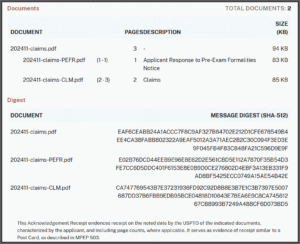
Here is part of an actual Patent Center Acknowledgment Receipt. It says things that are untrue about what the filer e-filed. And Patent Center fails to preserve what the filer e-filed in a way that would permit the filer to use the “message digest” to prove what had been e-filed.
The Ack Receipt says:
This Acknowledgement Receipt evidences receipt on the noted date by the USPTO of the indicated documents, characterized by the applicant, and including page counts, where applicable. It serves as evidence of receipt similar to a post card, as described in MPEP 503.
What I e-filed was a PDF of 3 pages named “202411-claims.pdf”, with a hash (what the USPTO calls a “message digest”) that starts with EA and ends with 9F. The Ack Receipt does accurately report the hash for that file.
The untruths. The Ack Receipt goes on to say (falsely) that I e-filed some PDF file named 202411-claims-PEFR.pdf, with a page count of 1, and with a size of 83KB, and with a hash starting with E0 and ending with 2E. I did not. So far as I know, no such file has ever existed anywhere — not in my computer, and not at the USPTO.
If you feel like it, you could click around in Patent Center to try to find some file that roughly corresponds to that file. There is an entry in IFW that says PEFR and there is a PDF link to download a PDF file. But the file that you get if you click on that link is not named “202411-claims-PEFR.pdf”. It is named “133517_18707611_11-08-2024_PEFR.PDF” which is a very different file name. (Note, to add insult to injury, that the USPTO does not even follow its own rule for file names, failing to provide the file extension “PDF” in lowercase.) You can download this file if you like, and you can calculate its hash if you like. The hash for the file from IFW starts with “00” and ends with “02”. It is also false to say that this file was “characterized by the applicant”.
Similarly the Ack Receipt likewise says (falsely) that I e-filed some PDF file named 202411-claims-CLAIMS.pdf, with a page count of 2, and with a size of 85KB, and with a hash starting with CA and ending with D5. I did not.
Failure to preserve. The file that I did actually upload, called “202411-claims.pdf”, is the file that I would desperately require if I ever found the need to prove exactly what I filed. The only way to use the Ack Receipt to prove it is by taking that file “202411-claims.pdf” and calculating its hash, and seeing whether or not the calculated hash is a match for the hash that is memorialized in the Ack Receipt.
The disappointing thing is that the USPTO has designed Patent Center in a way that fails to preserve the actual file that I uploaded.
This means that TYFNIL (ten years from now in litigation), it would be impossible to use actual resources in the USPTO’s application file to prove what was actually filed. This is a trap for the unwary.
As a practical matter, the only way to protect from this trap for the unwary is for the filer to preserve the file “202411-claims.pdf” locally. It will be appreciated that the local preservation needs to be in perpetuity, or at least until the end of any possible litigation time (at least six years past the end of the twenty-year term of the would-be granted patent).
I suppose one possible alternative way to try to protect from this trap for the unwary is for the filer to e-file the file “202411-claims.pdf” a second time, indexing it as non-black-and-white drawings. This would cause Patent Center to store the file in SCORE. The past behavior of the USPTO systems has been that any file in SCORE gets preserved bit-for-bit.
The problem is bigger. The problem is bigger than just the PDF-related problem just described. This problem of untruths about PDF e-filings, and failures-to-preserve about PDF e-filings, are not the only problems with the Ack Receipts generated by Patent Center. A couple of years ago, the filing community identified similar problems with the Ack Receipts in connection with DOCX e-filings. (In a DOCX e-filing, the USPTO fails to preserve the actual DOCX file that the filer uploaded, and if the filer chooses to upload an auxiliary PDF, the USPTO fails to preserve the auxiliary PDF.)
What USPTO ought to do. The USPTO ought to scrap the existing software that generates Ack Receipts, and ought to take a fresh start at accurately memorializing exactly what was e-filed and avoiding saying things that are not true about what was e-filed. The USPTO ought to preserve the actual files that the filer e-filed, so that TYFNIL it would be possible to prove what had been e-filed using information actually contained in the application file.

I love that Patent Center creates the file with the all caps “.PDF” file name. Great catch. As infuriating as the inconsistency of filling in USPTO-defined fields with or without slashes and commas – 12/345,678 vs. 12345678. Can the USPTO just give their programmers a master style guide for this stuff already?
God forbid they just save the freaking files that we submit. smh.